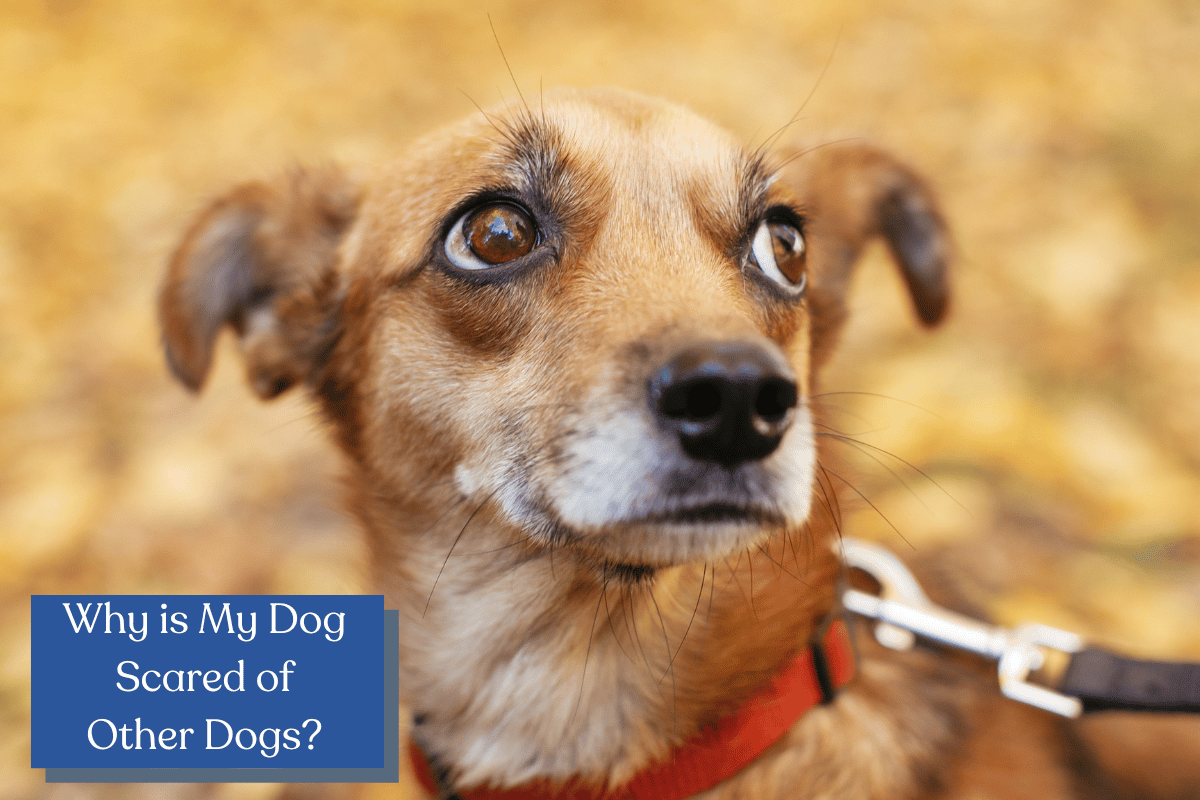Figuring out the riddle of “Why is my dog scared of other dogs” has become a passion of mine. I have a reactive canine who has been dealing with this issue for a long time. So I thought it was time to share what I’ve learned from researching and attempting to overcome this phobia.
In doing so, I intend to help fellow dog lovers manage and even overcome it for some owners. So let us not waste any more time and dive into the causes behind your dog’s fearfulness.

Why Your Dog is Scared of Other Dogs?
Everyone envisions their dog being best friends with other canines. It certainly makes things much easier for owners and offers plenty of adorable picture opportunities. Plus, it makes having a multi-dog household more possible.
But sadly, it’s not always a realistic dream. Some dogs won’t get along with other pups, even showing fear at times. It can be an overwhelming challenge for owners if they can’t help their pets overcome or manage this fearfulness.
The first step to managing a dog’s fear is figuring out what’s causing it. In most cases, this phobia will come from past trauma, a lack of socialization, or a submissive personality.

1. Past Trauma
Past trauma can have a long-lasting impact on our favorite canines. One of the more common incidents would be altercations with other dogs. If this happens, a dog may become fearful of other future altercations.
In these situations, the fearful dog will act unsure around unfamiliar dogs. They’ll often expect the worst to happen and respond by being overly aggressive or timid. But sometimes, you can overcome the trauma with time/patience.
2. Lack of Socialization
Dogs who don’t have much experience with other canines don’t respond well to meeting one. It shouldn’t be shocking because dogs aren’t too fond of unfamiliar situations. So encountering another same-sized animal is a recipe for disaster.
Most experts recommend early socialization to avoid these situations. It should begin with time spent with their litter mates and continue throughout their lives. Due to this, it’ll limit harmful interactions while showcasing the benefits of new experiences.
3. Submissive Personality
Some breeds or litter runts will have a more submissive personality. It’ll cause them to avoid interacting with other, more dominant dogs. Due to this, your dog will seem more afraid of other canines than you’d expect.
Owners can have success teaching their canines to be a bit more assertive. But this instinct won’t ever go away completely. So an owner must do their best to help their pups during these circumstances.
How to Tell Your Dog Is Scared of Other Dogs
Understanding why a dog may fear other canines is only one step. You must also know how to identify when they’re feeling scared or anxious.; an owner can’t address the situation if they aren’t sure whether this dog is scared.
So it’d be wise to look at all the potential warning signs. This information will ensure you can get a handle on what’s happening and relieve any stress. Let’s not waste any more time and dive into them:
Exaggerating licking of their lips
Forceful yawns
Nervous whining
Barking or growling
Shaking
Attempts to cower behind their owners
Slowed walking
Tucked tail
Owners should mitigate the situation if these signs present themselves. Otherwise, it could cause your dog to start being more aggressive. It’s a defensive tactic to ensure another negative experience doesn’t occur: snapping, aggressively barking, or loudly growling.
But please, don’t overreact to the situation. Yelling or screaming will only compound the issue into a negative one more quickly. It’s better to be calm but stern with a command or go in the opposite direction.
Once they reach the aggression stage, the situation often can’t be flipped into a positive one. You’re better off leaving the area and trying again another day.
What You Can Do to Help Manage Your Dog’s Fear
Owners often ask me what they can do if their dog is afraid of other pups. Well, it becomes all about managing their fear and trying to overcome it with patience. But it’s critical to remember that some dogs won’t conquer the issue under any circumstances.
However, it never hurts to try and see how your dog responds. So below, I dive into a few tips on helping your dog manage or overcome their canine phobia. Following them should ensure these situations aren’t as overwhelming for owners and scared dogs.
1. Avoid Stressful Situations
The easiest method of managing a dog’s fears is to avoid stressful situations. In other words, don’t force your dog to experience these circumstances. So don’t take them to a dog park and expect a marvelous recovery.
It’ll only make the fear worse and further ingrain the negative experiences. Instead, deal with these situations as they come calmly and naturally.
Let’s say you come across a dog when walking yours down the street. Your response shouldn’t be to turn away immediately or become overly anxious. Your dog will feel this tension and become overly aware of what’s happening.
A much better idea is not reacting and proceeding on the walk. If necessary, calmly cross the stress or turn toward another direction that doesn’t result in a confrontation.
2. Try to Socialize Your Dog in Familiar Spaces
Socialization is vital to helping any dog deal with unfamiliar experiences. But since your dog is terrified of other dogs, this process has to be done more gently. You should make them meet canines in safe, familiar places rather than out in the world.
Logically, it’d make sense to do it in your backyard, but this area can be problematic. Your dog could feel territorial over it and cause other issues. So I’d recommend a secluded place where they’ve been constantly outside their home.
This area would be a safe place to allow the parameters for successful interactions. You can then use all the positive reinforcement techniques to encourage them. I’d also suggest choosing a socialized dog for them to meet who’s calm and doesn’t have a dominant personality.
The video below shows some great tips:
3. Provide Plenty of Exercise
Exercise is an excellent way to keep your dog’s mind off their anxiety and stress. So if you plan on introducing them to a dog, take them on a strenuous walk or run. It’ll help them become more relaxed and release any pent-up energy.
You’ll also want to provide more exercise daily for an overwhelmed dog. Find an appealing activity and do it consistently. It’ll make your dog more comfortable outside the home while exposing them to safe experiences.
For instance, my Beagle loves leashed walks on trails. I take him on trails during hours when I don’t often see other dogs to help deal with anxiousness. It’s improved his overall temperament considerably compared to when I first got him.
It also provides a safe environment to deal with interactions with other dogs. More importantly, these experiences aren’t too frequent, which lessens overall stress. So it offers a good balance between managing fearfulness and overcoming it slowly.
4. Concentrate On Barking And Growling
Owners should do their best to curb any barking or growling. The first step would be noting what actions trigger this response. You can then plan your walks or other activities around these triggers.
After all, barking and growing is a form of severe aggression. These animals only resort to these behaviors when they feel overly defensive or unsafe. So it’s a massive clue of what could be causing your dog’s aversion to interactions with other pups.
For instance, my Beagle has a severe problem running into bigger dogs. He must show he’s the badest dog in the park. Trust me; he’s far from it, but it’s helpful info as I know his problem area and how to avoid it easily.

5. Put Effort into Leash Training
Most people don’t realize that a leash can have a negative impact on some dogs. It can even cause them to become more aggressive than expected. But it doesn’t mean that they should be off-leash at all times.
If anything, their aggression means they require more leash training. You need to get them more comfortable with being attached to one. I’d start by walking them around the backyard and house to provide more comfort with it.
Once they become more comfortable, the aggression on walks could lessen. It may be the reason your dog’s overly aggressive towards other pups. But I’d remain cautious about entering stressful situations even with more advanced leash training.
6. Call in a Professional
If none of these tactics are improving your dog’s fearful behavior, it’s time to call in the experts. Set up an appointment with a professional trainer or behaviorist. I’d recommend talking to a vet about their recommendations, as they know the field better than anyone.
Of course, I’m aware some owners can’t afford these lessons. In these cases, manage the issues as much as possible. Do everything to make your dog feel comfortable and help them avoid feeling stressed/overwhelmed.
7. Understand Your Dog May Never Get Over Their Fear
Some dogs simply won’t overcome this fear of other canines. Owners must recognize this outcome before going into this process. So if all these tips fail, don’t feel bad or disappointed with your dog’s performance.
Understanding this potential failure will help you remain positive during the process. It’ll ensure you can celebrate every piece of progress with the praise it deserves. Remember, it’s not your dog’s fault that this phobia has entered its life.
So overall, be patient and don’t expect miracles to happen immediately. It’s more than okay if your dog doesn’t become a superstar at the dog park. Your goal should be much more realistic, such as having a few puppy friends developed in controlled settings.
Conclusion
Your dog’s canine phobia likely comes from a traumatic experience, lack of socialization, or a submissive personality. There are several ways to manage or overcome these issues, from avoiding stressful situations to hiring a professional trainer.
But you must be patient and not expect the process to be linear. It could be a life-long task that requires constant training and effort to reap successful results. But I’m sure everyone will find it worth doing to improve their dog’s quality of life.
If you have any more questions, post them in our comment section. I’d love to help anyone trying to help a dog with this phobia. Thanks for reading!


